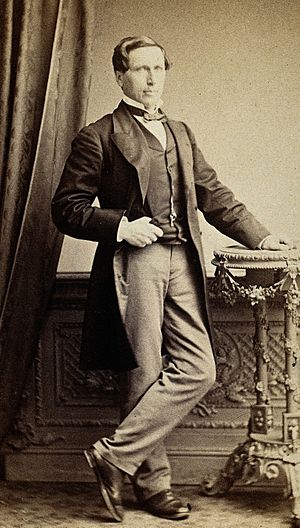William Brinton facts for kids
William Brinton (born November 20, 1823 – died January 17, 1867) was an English doctor. He was known for his work on stomach and digestive system problems. He also enjoyed climbing mountains in his free time.
Contents
Early Life and Education
William Brinton was born in Kidderminster, England. His father made carpets for a living. William went to private schools and then trained with a surgeon in Kidderminster.
In 1843, he started studying medicine at King's College, London. He was a very good student and won many awards. He earned his first medical degree (M.B.) in 1847. A year later, in 1848, he received a higher medical degree (M.D.).
Becoming a Doctor
In 1849, William Brinton became a member of the College of Physicians. This is a group for important doctors. By 1854, he became a "Fellow" of the college, which is a high honor.
He started teaching at St. Thomas's Hospital in London. He taught about forensic medicine, which is how medical knowledge helps in legal cases. He also taught about physiology, which is the study of how the human body works.
William Brinton became a very busy doctor. He was a physician at St. Thomas's Hospital. In 1854, he married Mary Danvers and they lived in London.
Medical Work and Interests
Dr. Brinton was especially interested in problems with the stomach and intestines. He often helped patients with intestinal obstruction, which is when something blocks the intestines.
In 1859, he gave special lectures called the Croonian lectures. These talks were about intestinal obstruction. In 1864, he was chosen to be a Fellow of the Royal Society. This is a very respected group for scientists.
Outside of his medical work, William Brinton loved to travel. He often spent his holidays in the Tyrol region, which is known for its mountains. He was an active member of the Alpine Club, a group for mountain climbers. He even wrote two articles about his climbing adventures.
Sadly, Dr. Brinton became ill with renal disease (kidney disease) in 1863. He passed away on January 17, 1867. He had six children, and one of his sons also became a doctor.
His Books and Writings
William Brinton wrote many important medical papers and books. In 1848, he sent a paper to the Royal Society about how the digestive system works. He also wrote "clinical remarks," which were notes from his medical cases, for a medical journal called The Lancet.
In 1857, he published a book called Pathology, Symptoms, and Treatment of Ulcer of the Stomach. This was the first complete book in England about stomach ulcers. He also wrote Lectures on the Diseases of the Stomach in 1859, which was updated in 1864. This book included new observations, like what the stomach sometimes looks like after death in cases of scarlet fever. He also showed that "gout in the stomach" was not a real medical condition.
Dr. Brinton wrote many articles for medical magazines. He translated a German textbook about physiology in 1853. He also wrote a short book in 1856 about how doctors choose people for life insurance. In 1861, he published On Food and its Digestion, being an Introduction to Dietetics, which was about healthy eating. He also wrote six articles for a large medical encyclopedia.
After he died, his friend Dr. Buzzard edited a book based on his lectures about intestinal obstruction. All of Dr. Brinton's books were based on careful observations from his medical practice.


